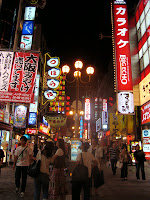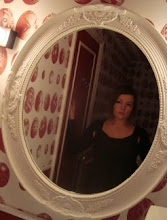 After visiting Kansai's cultural center, I paid its economic center a visit. Ōsaka is not famed for its touristic appeal, but I had met some "natives" along the way whom I wanted to visit and also it offers some good museums. It's the second biggest city in Japan, with a population of about 2.5, so despite being a big city it's a dwarf version of Tokyo.
After visiting Kansai's cultural center, I paid its economic center a visit. Ōsaka is not famed for its touristic appeal, but I had met some "natives" along the way whom I wanted to visit and also it offers some good museums. It's the second biggest city in Japan, with a population of about 2.5, so despite being a big city it's a dwarf version of Tokyo. The first evening I met a guy I had met in Okinawa. He first took me to a Takoyaki shop to taste this local staple. Takoyaki are fried squid balls and it is pretty delicious. Ōsaka by the way also has a special version of my of my almost favourite dish, Okonomiyaki. We walked around the neon lit streets of central Ōsaka. Restaurants, game parlours, shopping arcades, etc. whereever you see. A lot of very trendy shops line the street of "Amerika miura" (American village) and its adjacent streets. You see that reflected in people's dress. While the Japanese are very fashionable in general, this is even more pronounced in big cities like this. Very avant-garde and you feel tempted to spend a lot of money... Just the thought of my already too heavy luggage made me step back and think twice :-).
The next day I visited some of the museums. Ōsaka's aquarium features a giant whale shark. I had wanted to see some other aquariums in Japan, but somehow never got around to doing it. This one was really nice, you could walk in tunnels with fish all around you. And the tank with the whale shark and several mantas was just huge. Of course the Japanese visitors were screaming "kawaii" (cute) non-stop (this word for sure is the most over-used in this country!). But some people are still being a bit reasonable. There was a family watching the  seals and they kept repeating "kawaii, kawaii". Then the father said: " Well, actually they are fighting and biting each other, that's not so "kawaii"". Made me applaud almost... This word can get on your nerves at times, because everything is "kawaii" here.
seals and they kept repeating "kawaii, kawaii". Then the father said: " Well, actually they are fighting and biting each other, that's not so "kawaii"". Made me applaud almost... This word can get on your nerves at times, because everything is "kawaii" here.
 seals and they kept repeating "kawaii, kawaii". Then the father said: " Well, actually they are fighting and biting each other, that's not so "kawaii"". Made me applaud almost... This word can get on your nerves at times, because everything is "kawaii" here.
seals and they kept repeating "kawaii, kawaii". Then the father said: " Well, actually they are fighting and biting each other, that's not so "kawaii"". Made me applaud almost... This word can get on your nerves at times, because everything is "kawaii" here. Situated right next to the aquarium is the "Santori" museum which features an excellent art collection and an IMAX cinema, I visited both of them as well. "Santori" by the way always reminds me of the film "Lost in Translation". Bill Murray's character in the film is in Japan to do a commercial for "Santori whiskey" and he has to drink the stuff over and over again, struggling to look cheerful.
The museum I was most interested in was the "Human Rights Museum". It talks about human rights in Japan and the various groups whose human rights have been violated in the past or present. There are two domestic ethnic groups, the Ainu (from Hokkaido) and the Okinawans who have been forcedly "japanized" and whose culture was marginalized for a long time. These days there are increased efforts to preserve their culture and language. Another group are the "buraku", the lowest caste (Japan used to have a caste system) who were tasked to bury the dead or produce leather. They were considered "unclean" and discrimination has long remained even after the caste system was abolished, e.g. they were discriminated against on the labour market. A special exhibition talks about the Korean population in Japan. Many Koreans either  voluntarily emigrated to Japan or were brought here as slave labourers during Japanese occupation of Korea. They continue to be disadvantaged on the labour market until today. The exhibition talked about other groups as well such as disabled people, women, day labourers, etc. The museum features a good introductory part that hints at Japanese society's desire to streamline lifestyle and objectives and the related tendency to marginalize outsiders that do not fit into the common lifestyle model. The old Japanese saying goes: "The nail that stands out gets quickly hammered down".
voluntarily emigrated to Japan or were brought here as slave labourers during Japanese occupation of Korea. They continue to be disadvantaged on the labour market until today. The exhibition talked about other groups as well such as disabled people, women, day labourers, etc. The museum features a good introductory part that hints at Japanese society's desire to streamline lifestyle and objectives and the related tendency to marginalize outsiders that do not fit into the common lifestyle model. The old Japanese saying goes: "The nail that stands out gets quickly hammered down".
 voluntarily emigrated to Japan or were brought here as slave labourers during Japanese occupation of Korea. They continue to be disadvantaged on the labour market until today. The exhibition talked about other groups as well such as disabled people, women, day labourers, etc. The museum features a good introductory part that hints at Japanese society's desire to streamline lifestyle and objectives and the related tendency to marginalize outsiders that do not fit into the common lifestyle model. The old Japanese saying goes: "The nail that stands out gets quickly hammered down".
voluntarily emigrated to Japan or were brought here as slave labourers during Japanese occupation of Korea. They continue to be disadvantaged on the labour market until today. The exhibition talked about other groups as well such as disabled people, women, day labourers, etc. The museum features a good introductory part that hints at Japanese society's desire to streamline lifestyle and objectives and the related tendency to marginalize outsiders that do not fit into the common lifestyle model. The old Japanese saying goes: "The nail that stands out gets quickly hammered down". 
No comments:
Post a Comment